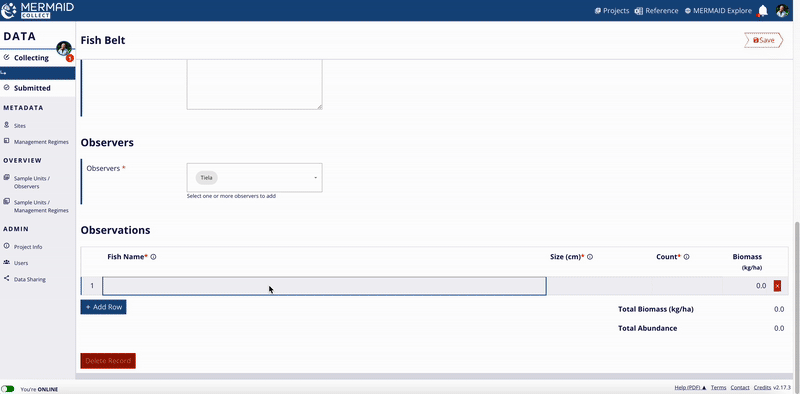Click on 'Reference' in the main toolbar (upper right of Collect) to download an xlsx file of all benthic attributes and fish species / genera / families that are used in MERMAID. This works offline as well as online.

In the XLSX file, you will find five sheets: Fish Families, Fish Genera, Fish Species, Fish Groupings, and Benthic. Each sheet provides information for that taxonomic level. Using filters, you can search and sort for the specific information you are looking for.

Fish and benthic attributes in MERMAID are standardized, and aligned with accepted names in the World Register of Marine Species (WORMS), eliminating discrepancies between different users' data. However, if you want to record an observation of something you think is missing, you can propose to add it in the app, and it will be reviewed by the MERMAID team. Before adding a new fish or benthic species, please make sure that you are using the accepted scientific name by WORMS.
Once you propose a new fish species or benthic attribute, you can directly use it while entering data. The MERMAID team will either accept your proposal, making it available for all other MERMAID users, or work with you to normalize the proposed species or attribute with an existing one; either way, we will let you know by email.
Propose new fish species
In any fish belt transect, scroll down to the Observations table.
Type the fish species that you want to add. When what you have typed does not match any fish species in MERMAID, the option to propose a new species will appear.
Click the “Propose New Species” option.
Type the genus name in the Genus field. If the genus you are looking for is not there ("No results found"), send us an email by clicking “Contact” button in the bottom right of the app.
Type the species name in the Species field and click "Next".
Click "Send to MERMAID for review" to complete your proposal.

Propose a new benthic attribute
In any benthic transect, scroll down to the Observations table
Type the benthic attribute that you want to add. When what you have typed does not match any benthic attribute in our database, the option to propose a new benthic attribute will appear.
Click the “Propose New Benthic Attribute” option.
Type the parent name in the Parent field. Typically, "Parent" will be a coral genus or family, but can be a non-trophic attribute. For example, to add a new Acropora species named Acropora test, type/select Acropora in the Parent field, then type Acropora test in the Name field, and click “Next”.
Click "Send to MERMAID for review" to complete your proposal.

Standard taxonomic hierarchies
MERMAID has developed a single set of standard taxonomic hierarchies for reef fish and benthic observations that are shared across Collect, Explore and R Package. This eliminates lengthy data cleaning, simplifies analysis, and makes it easy to create reproducible charts and reports from your data.
Reef fish observations aggregate from species to genus to family to trophic group (e.g. herbivore, planktivore, etc).
Benthic observations aggregate from species to genera to family to a benthic top-level category (e.g. hard coral, soft coral, macroalgae).

Reef fish observations
For reef fish observations, the biomass constants, maximum length, trophic level, fishing vulnerability, climate score, and geographic distribution are drawn from FishBase.
Since reference values of biomass constants and trophic level are provided by species in FishBase, when using a genus- or family-level fish observation in Collect, MERMAID automatically averages species-level values. For example, typing "Acanth'' allows you to record an observation for the "Acanthuridae" family, the "Acanthurus" genus, or the "Acanthurus achilles" species; if you choose "Acanthurus", biomass constants will be the averages of all species in the "Acanthurus" genus.
Benthic observations
MERMAID uses a hierarchical taxonomy of benthic attributes. This means that every attribute can be ‘rolled up’ into one of 12 top-level benthic categories, which are available in xlsx data downloads from MERMAID and shown in the MERMAID Explore.
The 12 top-level categories are:
Bare substrate (e.g., rock)
Crustose coralline algae
Cyanobacteria
Hard coral
Macroalgae
Other (e.g., trash, plastic, etc)
Other invertebrates
Rubble
Sand (including silt)
Seagrass
Soft coral
Turf algae (including dead coral or dead coral with algae)
For example, ‘Acropora palmata’ rolls up to ‘Acropora’ then ‘Acroporidae’ then the final top-level category of ‘Hard coral’. Top-level category classifications are provided as a separate column in xlsx downloads from your submitted MERMAID data.
Custom analyses, such as calculating percentages for benthic attributes that are not top-level categories, can be done using observation-level data by exporting submitted data from a project or accessing directly using our R package.
Using a ‘blank’ filter in the Parent column of the Reference xlsx file will provide you with a list of the 12 top-level categories.

Filtering for a specific benthic attribute in the "Parent" column will show all benthic attributes that belong to it.
